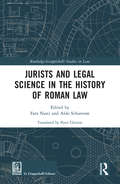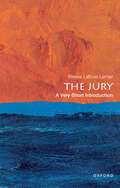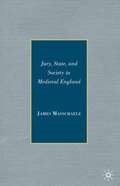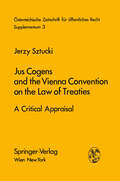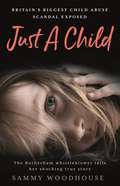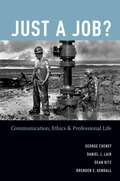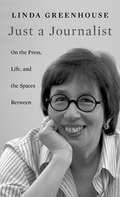- Table View
- List View
Jurists and Legal Science in the History of Roman Law (Routledge-Giappichelli Studies in Law)
by Fara NastiThis book provides a new approach to the study of the History of Roman Law. It collects the first results of the European Research Council Project, Scriptores iuris Romani - dedicated to a new collection of the texts of Roman jurisprudence, highlighting important methodological issues, together with innovative reconstructions of the profiles of some ancient jurists and works. Jurists were great protagonists of the history of Rome, both as producers and interpreters of law, since the Republican Age and as collaborators of the principes during the Empire. Nevertheless, their role has been underestimated by modern historians and legal experts for reasons connected to the developments of Modern Law in England and in Continental Europe. This book aims to address this imbalance. It presents an advanced paradigm in considering the most important aspects of Roman law: the Justinian Digesta, and other juridical late antique anthologies. The work offers an historiographic model which overturns current perspectives and makes way for a different path for legal and historical studies. Unlike existing literature, the focus is not on the Justinian Codification, but on the individualities of ancient Roman Jurists. As such, it presents the actual legal thought of its experts and authors: the ancient iuris prudentes. The book will be of interest to researchers and academics in Classics, Ancient History, History of Law, and contemporary legal studies.
Jurists and Legal Science in the History of Roman Law (Routledge-Giappichelli Studies in Law)
by Fara Nasti Aldo SchiavoneThis book provides a new approach to the study of the History of Roman Law. It collects the first results of the European Research Council Project, Scriptores iuris Romani - dedicated to a new collection of the texts of Roman jurisprudence, highlighting important methodological issues, together with innovative reconstructions of the profiles of some ancient jurists and works. Jurists were great protagonists of the history of Rome, both as producers and interpreters of law, since the Republican Age and as collaborators of the principes during the Empire. Nevertheless, their role has been underestimated by modern historians and legal experts for reasons connected to the developments of Modern Law in England and in Continental Europe. This book aims to address this imbalance. It presents an advanced paradigm in considering the most important aspects of Roman law: the Justinian Digesta, and other juridical late antique anthologies. The work offers an historiographic model which overturns current perspectives and makes way for a different path for legal and historical studies. Unlike existing literature, the focus is not on the Justinian Codification, but on the individualities of ancient Roman Jurists. As such, it presents the actual legal thought of its experts and authors: the ancient iuris prudentes. The book will be of interest to researchers and academics in Classics, Ancient History, History of Law, and contemporary legal studies.
The Jury: A Very Short Introduction (Very Short Introductions)
by Renée Lettow LernerAlmost every society has professional judges, but from ancient Athens to modern Asia, cultures have wanted ordinary people involved in legal decisions. The use of juries comes with challenges; societies must determine how to select jurors, what cases jurors should decide and by what rules, and how to inform jurors about the law and evidence. This Very Short Introduction shows how and why societies around the world have used juries, charting the spread of the twelve-person jury from England to the British colonies in America, Canada, India, Australia, New Zealand, and the Caribbean. In criminal cases, use of lay jurors has stretched to nations in Europe, Latin America, and Asia as they aspire to democracy, greater popular participation in government, and legitimacy of the justice system. But in English-speaking countries, jury trials are declining. Civil juries have been virtually abolished everywhere except the United States, and even there they are rare. In criminal cases, plea bargaining is now taking the place of jury trials. In this book, Renée Lettow Lerner describes the benefits and challenges of using juries, including jury nullification, and considers how innovations from non-English-speaking countries may be key to the survival of lay participation. Along the way, the book tells how a small German state invented a way of using jurors that is now found around the world. And it reveals why some defendants preferred to be crushed to death by weights rather than convicted by a jury.
The Jury: A Very Short Introduction (Very Short Introductions)
by Renée Lettow LernerAlmost every society has professional judges, but from ancient Athens to modern Asia, cultures have wanted ordinary people involved in legal decisions. The use of juries comes with challenges; societies must determine how to select jurors, what cases jurors should decide and by what rules, and how to inform jurors about the law and evidence. This Very Short Introduction shows how and why societies around the world have used juries, charting the spread of the twelve-person jury from England to the British colonies in America, Canada, India, Australia, New Zealand, and the Caribbean. In criminal cases, use of lay jurors has stretched to nations in Europe, Latin America, and Asia as they aspire to democracy, greater popular participation in government, and legitimacy of the justice system. But in English-speaking countries, jury trials are declining. Civil juries have been virtually abolished everywhere except the United States, and even there they are rare. In criminal cases, plea bargaining is now taking the place of jury trials. In this book, Renée Lettow Lerner describes the benefits and challenges of using juries, including jury nullification, and considers how innovations from non-English-speaking countries may be key to the survival of lay participation. Along the way, the book tells how a small German state invented a way of using jurors that is now found around the world. And it reveals why some defendants preferred to be crushed to death by weights rather than convicted by a jury.
Jury and the Defense of Insanity
by Rita J. SimonThirty years after it was first published, the issues raised in The Jury and the Defense of Insanity remain pertinent. Rita James Simon examines how motivated and competent juries are, how well jurors understand and follow judges' instructions, their understand-ing of expert testimony, and the extent to which their own backgrounds and experiences influence their decisions. Simon provides a rare opportunity to observe how jurors go about the process of deliberating and reaching a verdict by following them into the jury room and recording their deliberations. This pathbreaking study of jury room behavior provides compelling evidence of the effectiveness of our trial by jury system.The Jury and the Defense of Insanity was the product of an experimental study con-ducted as part of the University of Chicago Jury Project. Over 1,000 jurors were chosen to participate, not as volunteers, but as part of their regular jury duty, in two experimental trials, one on a charge of housebreaking, the other of incest. In each the insanity de-fense was raised. Court judges instructed the jurors to consider the recorded trials they were about to hear with all the care and seriousness they would give to a real criminal prosecution, and the taped recordings of their deliberations make it clear that they did just that. These recordings, along with responses to detailed questionnaires, yielded significant data, equally applicable to civil as to criminal cases. We learn their reactions to their fellow jurors; personal evaluations of the quality and effectiveness of delibera-tions; the degree to which religion, sex, social status, education, and like factors affect participation in and influence on the course of the deliberation; and the recounting of and reliance upon personal experience in seeking to reach a verdict, among other in-sights furnished by this study.This is an exact record not a description or recollected account of the struggle of a jury to weigh evidence and achieve a just verdict. For lawyers whose job it is to win civil and criminal cases, for behavioral scientists who study male and female reactions in their cultural environment to the circumstances that confront them, and to all who are interested in how people behave and why, in a dramatic, socially significant situation, this is a fascinating and revealing book.
Jury and the Defense of Insanity
by Rita J. SimonThirty years after it was first published, the issues raised in The Jury and the Defense of Insanity remain pertinent. Rita James Simon examines how motivated and competent juries are, how well jurors understand and follow judges' instructions, their understand-ing of expert testimony, and the extent to which their own backgrounds and experiences influence their decisions. Simon provides a rare opportunity to observe how jurors go about the process of deliberating and reaching a verdict by following them into the jury room and recording their deliberations. This pathbreaking study of jury room behavior provides compelling evidence of the effectiveness of our trial by jury system.The Jury and the Defense of Insanity was the product of an experimental study con-ducted as part of the University of Chicago Jury Project. Over 1,000 jurors were chosen to participate, not as volunteers, but as part of their regular jury duty, in two experimental trials, one on a charge of housebreaking, the other of incest. In each the insanity de-fense was raised. Court judges instructed the jurors to consider the recorded trials they were about to hear with all the care and seriousness they would give to a real criminal prosecution, and the taped recordings of their deliberations make it clear that they did just that. These recordings, along with responses to detailed questionnaires, yielded significant data, equally applicable to civil as to criminal cases. We learn their reactions to their fellow jurors; personal evaluations of the quality and effectiveness of delibera-tions; the degree to which religion, sex, social status, education, and like factors affect participation in and influence on the course of the deliberation; and the recounting of and reliance upon personal experience in seeking to reach a verdict, among other in-sights furnished by this study.This is an exact record not a description or recollected account of the struggle of a jury to weigh evidence and achieve a just verdict. For lawyers whose job it is to win civil and criminal cases, for behavioral scientists who study male and female reactions in their cultural environment to the circumstances that confront them, and to all who are interested in how people behave and why, in a dramatic, socially significant situation, this is a fascinating and revealing book.
The Jury Master (David Sloane Ser. #Bk. 1)
by Robert DugoniNEW YORK TIMES BESTSELLER"John Grisham, move over...A riveting tale of murder, treachery, and skullduggery at the highest levels." - Seattle TimesIn a courtroom, David Sloane can grab a jury and make it dance. He can read jurors' expressions, feel their emotions, know their thoughts. With this remarkable ability, Sloane gets juries to believe the unbelievable, excuse the inexcusable, and return the most astonishing verdicts. The only barrier to Sloane's professional success is his conscience -- until he gets a call from a man later found dead, and his life rockets out of control.
Jury, State, and Society in Medieval England (PDF)
by James MasschaeleThis book portrays the great variety of work that medieval English juries carried out while highlighting the dramatic increase in demands for jury service that occurred during this period.
Jury Trials and Plea Bargaining: A True History
by Mike McConville Chester L MirskyThis book is a study of the social transformation of criminal justice, its institutions, its method of case disposition and the source of its legitimacy. Focused upon the apprehension, investigation and adjudication of indicted cases in New York City's main trial tribunal in the nineteenth century - the Court of General Sessions - it traces the historical underpinnings of a lawyering culture which, in the first half of the nineteenth century, celebrated trial by jury as the fairest and most reliable method of case disposition and then at the middle of the century dramatically gave birth to plea bargaining, which thereafter became the dominant method of case disposition in the United States. The book demonstrates that the nature of criminal prosecutions in everyday indicted cases was transformed, from disputes between private parties resolved through a public determination of the facts and law to a private determination of the issues between the state and the individual, marked by greater police involvement in the processing of defendants and public prosecutorial discretion. As this occurred, the structural purpose of criminal courts changed - from individual to aggregate justice - as did the method and manner of their dispositions - from trials to guilty pleas. Contemporaneously, a new criminology emerged, with its origins in European jurisprudence, which was to transform the way in which crime was viewed as a social and political problem. The book, therefore, sheds light on the relationship of the method of case disposition to the means of securing social control of an underclass, in the context of the legitimation of a new social order in which the local state sought to define groups of people as well as actual offending in criminogenic terms."At a moment when France is poised to adopt plea bargaining, McConville and Mirsky offer the best historical account of its emergence in mid-nineteenth century America, based upon exhaustive analysis of archival data. Their interpretation of the reasons for the dramatic shift from jury trials to negotiated justice offers no comfort for contemporary apologists of plea bargaining as more "professional." The combination of new data and critical reflection on accepted theories make this essential reading for anyone interested in criminal justice policy."Rick Abel, Connell Professor of Law, UCLA Law School"A fascinating account which traces the origins of plea-bargaining in the politicisation of criminal justice, linking developments in day-to-day practices of the criminal process with macro-changes in political economy, notably the structures of local governance. This is a classic socio-legal study and should be read by anyone interested in criminology, criminal justice, modern history or social theory". Nicola Lacey, Professor of Criminal Law and Legal Theory, London School of Economics.
The Jury Under Fire: Myth, Controversy, and Reform (American Psychology-Law Society Series)
by Brian H. Bornstein Edie GreeneAlthough the jury is often referred to as one of the bulwarks of the American justice system, it regularly comes under attack. Recent changes to trial procedures, such as reducing jury size, allowing non-unanimous verdicts, and rewriting jury instructions in plain English, were designed to promote greater efficiency and adherence to the law. Other changes, such as capping damages and replacing jurors with judges as arbiters in complex trials, seem designed to restrict the role of laypeople in trial outcomes. Whether these innovations are implemented to facilitate the administration of justice or due to the belief that juries have excessive power and make irrational decisions, they raise a host of questions about their effects on juries' judgments and about justice. Policymakers sometimes make incorrect assumptions about jury behavior, with the result that some reform efforts have had surprising and unintended consequences. The Jury Under Fire reviews a number of controversial beliefs about juries as well as the implications of these views for jury reform. It reviews up-to-date research on both criminal and civil juries that uses a variety of research methodologies: simulations, archival analyses, field studies, and juror interviews. Each chapter focuses on a mistaken assumption or myth about jurors or juries, critiques these myths, and then uses social science research findings to suggest appropriate reforms. Chapters discuss the experience of serving as a juror; jury selection and jury size; and the impact of evidence from eyewitnesses, experts, confessions, and juvenile offenders. The book also covers the process of deciding damages and punishment and the role of emotions in jurors' decision making, and it compares jurors' and judges' decisions. Finally, it reviews a broad range of efforts to reform the jury, including the most promising reforms that have a solid backing in research. Featuring highly visible trials to illustrate key points, The Jury Under Fire will interest researchers in psychology and the law, practicing attorneys, and policymakers, as well as students and trainees in these areas.
Jus ad Bellum: The Law on Inter-State Use of Force
by Stuart Casey-MaslenThis work expounds, for those in practice and beyond, the rules of international law governing the inter-state use of force. Jus ad bellum determines when a state - or group of states - may lawfully use force against, or on the territory of, another state, and when such action violates international law. The bedrock of the law is found in the Charter of the United Nations, but the interpretation and application of many of the rules codified in the Charter, particularly by the International Court of Justice, are contested. Accordingly, the book clarifies the law as it stands today, explaining its many complexities and controversies, such as when non-state actors may be attacked in another state and when consent is validly given to foreign intervention. The interrelationships between jus ad bellum and the law of armed conflict/international humanitarian law, the law of neutrality, and international human rights law are also illuminated, along with important concepts such as the 'responsibility to protect' and humanitarian intervention.
Jus ad Bellum: The Law on Inter-State Use of Force
by Stuart Casey-MaslenThis work expounds, for those in practice and beyond, the rules of international law governing the inter-state use of force. Jus ad bellum determines when a state - or group of states - may lawfully use force against, or on the territory of, another state, and when such action violates international law. The bedrock of the law is found in the Charter of the United Nations, but the interpretation and application of many of the rules codified in the Charter, particularly by the International Court of Justice, are contested. Accordingly, the book clarifies the law as it stands today, explaining its many complexities and controversies, such as when non-state actors may be attacked in another state and when consent is validly given to foreign intervention. The interrelationships between jus ad bellum and the law of armed conflict/international humanitarian law, the law of neutrality, and international human rights law are also illuminated, along with important concepts such as the 'responsibility to protect' and humanitarian intervention.
Jus Cogens (Elements of International Law)
by Dinah SheltonThe doctrine of peremptory norms (jus cogens) is a set of core obligations in international law. In this volume in the Elements of International Law series, Dinah Shelton explores its origins and history, its revival in the twentieth century, and its place in international and domestic jurisprudence. Providing a fresh, objective, and non-argumentative approach to the discipline of international law, the Elements series is an accessible go-to source for practicing international lawyers, judges and arbitrators, government and military officers, scholars, teachers, and students. Beginning with the writings of Grotius, Vattel, and Suarez, Shelton shows how the theory of jus cogens drew upon Roman law for its foundations. In the subsequent chapter, she considers the emergence of positivism and its rejection of any non-consensual basis for binding States to international norms. She then turns to the re-emergence of jus cogens in theories of the twentieth century and its place in the modern law of treaties. The volume includes extensive analysis of the interpretation of jus cogens obligations by international courts and tribunals, as well as by various domestic courts, including those of Italy, Greece, Canada, the US, and the UK. The volume concludes with a consideration of the place of jus cogens in modern scholarship.
Jus Cogens (Elements of International Law)
by Dinah SheltonThe doctrine of peremptory norms (jus cogens) is a set of core obligations in international law. In this volume in the Elements of International Law series, Dinah Shelton explores its origins and history, its revival in the twentieth century, and its place in international and domestic jurisprudence. Providing a fresh, objective, and non-argumentative approach to the discipline of international law, the Elements series is an accessible go-to source for practicing international lawyers, judges and arbitrators, government and military officers, scholars, teachers, and students. Beginning with the writings of Grotius, Vattel, and Suarez, Shelton shows how the theory of jus cogens drew upon Roman law for its foundations. In the subsequent chapter, she considers the emergence of positivism and its rejection of any non-consensual basis for binding States to international norms. She then turns to the re-emergence of jus cogens in theories of the twentieth century and its place in the modern law of treaties. The volume includes extensive analysis of the interpretation of jus cogens obligations by international courts and tribunals, as well as by various domestic courts, including those of Italy, Greece, Canada, the US, and the UK. The volume concludes with a consideration of the place of jus cogens in modern scholarship.
Jus Cogens: International Law And Social Contract
by Thomas WeatherallOne of the most complex doctrines in contemporary international law, jus cogens is the immediate product of the socialization of the international community following the Second World War. However, the doctrine resonates in a centuries-old legal tradition which constrains the dynamics of voluntarism that characterize conventional international law. To reconcile this modern iteration of individual-oriented public order norms with the traditionally state-based form of international law, Thomas Weatherall applies the idea of a social contract to structure the analysis of jus cogens into four areas: authority, sources, content and enforcement. The legal and political implications of this analysis give form to jus cogens as the product of interrelation across an individual-oriented normative framework, a state-based legal order, and values common to the international community as a whole.
Jus Cogens and the Vienna Convention on the Law of Treaties: A Critical Appraisal (Österreichische Zeitschrift für öffentliches Recht und Völkerrecht - Supplementa #3)
by Jerzy SztuckiArt. 53 of the Vienna Convention on the Law of Treaties of 23 May, 1969 (hereafter referred to as "the Convention")1, entitled "Treaties conflicting with a peremptory norm of general international law (jus cogens)", contains the following provision: «A treaty is void if, at the time of its conclusion, it conflicts with a peremptory norm of general international law. For the purpose of the present Convention, a peremptory norm of general international law is a norm accepted and recognized by the international community of States as a whole as a norm from whidt no derogation is permitted and whidt can be modified only by a subsequent norm of general international law having the same dtaracter". The concept is extended to newly emerging peremptory norms of general international law. Art.64 of the Convention, entitled "Emergence of a new peremptory norm of general international law (jus cogens)", runs as follows: "If a new peremptory norm of general international law emerges, any existing treaty whidt is in conflict with that norm becomes void and terminates".
Jus Post Bellum: Mapping the Normative Foundations
by Carsten Stahn Jennifer S. Easterday Jens IversonThis is an open access title available under the terms of a CC BY-NC-ND 4.0 licence. It is free to read at Oxford Scholarship Online and offered as a free PDF download from OUP and selected open access locations. The successful transition from armed conflict to peace is one of the greatest challenges of contemporary warfare. The laws and principles governing transitions from conflict to peace (jus post bellum) have only recently gained attention in legal scholarship. There are three key questions concerning the core of jus post bellum: the law ('jus'), the temporal aspect ('post'), and different types of armed conflict ('bellum') involved. This book explores the different legal meanings and components of the concept, including its implications in contemporary politics and practice. The book provides a detailed understanding of the development and nature of jus post bellum as a concept, including its foundations, criticisms, and relationship to related concepts (such as transitional justice, and the responsibility to protect). It investigates the relationship of the concept to jus ad bellum and jus in bello, and its relevance in internal armed conflicts and peacebuilding. There are significant problems brought about in relation to the ending of conflict, including indicators for the end of conflict, exit strategies, and institutional responses, which are also assessed. The book identifies the key components of a 'jus', drawing on disparate bodies and sources of international law such as peace agreements, treaty law, self-determination, norms governing peace operations and the status of foreign armed forces, environmental law, human rights, and amnesty law. Taking into account perspectives from multiple disciplines, the book is important reading for scholars, practitioners, and students across many fields, including peace and conflict studies, international relations, and international humanitarian law.
Just a Child: Britain's Biggest Child Abuse Scandal Exposed (PDF)
by Sammy WoodhouseSammy Woodhouse was just 14 when she met Arshid Hussain. Ten years older, he promised to take care of her. Sammy thought she was in love, but in reality she was being groomed by a ringleader of Britain's most notorious child sex ring. Just A Child tells the heartbreaking story of how a young girl from Rotherham was abused by her drug-dealing 'boyfriend', eventually giving birth to his baby, right under the nose of the very authorities who were meant to protect her. When reality dawned and Sammy realised she was one of countless vulnerable child victims - many of whom were trafficked around the north of England - she took it upon herself to blow the whistle and save others from a similar fate. Thanks to Sammy's bravery, the gang was fully exposed, as well as the authorities that did little to help her. Her shocking account of how these events came to pass will enrage and sadden but, above all, it will offer hope and show why this must never happen again.
Just a Job?: Communication, Ethics, and Professional Life
by George Cheney Daniel J. Lair Dean Ritz Brenden E. KendallFrom cartoons to boardrooms comes the statement, "It's not personal. It's just business." Just a Job? Communication, Ethics, and Professional Life offers a provocative perspective on ethics at work. The book questions the notions that doing ethics at work has to be work, and that work is somehow a sphere where a different set of rules applies. This problematic line between work and life runs through the ways we commonly talk about ethics, from our personal relationships to the domains of work, including the organization, the profession, and the market. Talk about ethics is far more than "just talk," and this book shows how and why it matters. Drawing from the fields of communication and rhetoric, the authors show how the very framing of ethics--even before we approach specific decisions--limits the potential roles of ethics in our work lives and the pursuit of happiness, and treats it as something that is meaningful only at special moments such as when faced with dilemmas, or as the last chapter in a business book. Separating ethics from life, we put it beyond our daily reach. The authors argue against ethical myopia limited to spectacular scandals or comprehensive professional codes. Instead, they propose a master reframe of ethics based on a new take on virtue ethics, including Aristotle's practical ideal of eudaimonia or flourishing, which tells new stories about the ordinary as well as extraordinary aspects of professional integrity and success. By reframing ethics as not special, they elevate it to its rightful position in work and personal life. Generously illustrated with examples and ideas from scholarly as well as popular sources, this book asks us to reconsider the meaning of and path toward the "good life."
Just a Job?: Communication, Ethics, and Professional Life
by George Cheney Daniel J. Lair Dean Ritz Brenden E. KendallFrom cartoons to boardrooms comes the statement, "It's not personal. It's just business." Just a Job? Communication, Ethics, and Professional Life offers a provocative perspective on ethics at work. The book questions the notions that doing ethics at work has to be work, and that work is somehow a sphere where a different set of rules applies. This problematic line between work and life runs through the ways we commonly talk about ethics, from our personal relationships to the domains of work, including the organization, the profession, and the market. Talk about ethics is far more than "just talk," and this book shows how and why it matters. Drawing from the fields of communication and rhetoric, the authors show how the very framing of ethics--even before we approach specific decisions--limits the potential roles of ethics in our work lives and the pursuit of happiness, and treats it as something that is meaningful only at special moments such as when faced with dilemmas, or as the last chapter in a business book. Separating ethics from life, we put it beyond our daily reach. The authors argue against ethical myopia limited to spectacular scandals or comprehensive professional codes. Instead, they propose a master reframe of ethics based on a new take on virtue ethics, including Aristotle's practical ideal of eudaimonia or flourishing, which tells new stories about the ordinary as well as extraordinary aspects of professional integrity and success. By reframing ethics as not special, they elevate it to its rightful position in work and personal life. Generously illustrated with examples and ideas from scholarly as well as popular sources, this book asks us to reconsider the meaning of and path toward the "good life."
Just a Journalist: On the Press, Life, and the Spaces Between (The William E. Massey Sr. lectures in American studies ; #2015)
by Linda GreenhouseA Pulitzer Prize–winning reporter who covered the Supreme Court for The New York Times, Linda Greenhouse trains an autobiographical lens on a moment of transition in U.S. journalism. Calling herself “an accidental activist,” she raises urgent questions about the role of journalists as citizens and participants in the world around them.
Just a Journalist: On the Press, Life, and the Spaces Between (The William E. Massey Sr. lectures in American studies ; #2015)
by Linda GreenhouseA Pulitzer Prize–winning reporter who covered the Supreme Court for The New York Times, Linda Greenhouse trains an autobiographical lens on a moment of transition in U.S. journalism. Calling herself “an accidental activist,” she raises urgent questions about the role of journalists as citizens and participants in the world around them.
Just a Number: An International Legal Analysis on Age Discrimination
by Anne-Marie Mooney CotterWhilst workers' organizations and third-party analysts around the world commonly cite age as the most prevalent form of discrimination in the workplace, age discrimination has not had the same high profile as discrimination on grounds of sex or race. This book allows readers to better understand the issue of ageism and inequality. It examines the primary role of legislation and court process in combating age discrimination at both national and international levels. Including the role of NAFTA and the EU in this respect, it also provides a detailed examination of the relationship between age issues and the law, and will be an important resource for those involved in age discrimination and elder rights.
Just a Number: An International Legal Analysis on Age Discrimination
by Anne-Marie Mooney CotterWhilst workers' organizations and third-party analysts around the world commonly cite age as the most prevalent form of discrimination in the workplace, age discrimination has not had the same high profile as discrimination on grounds of sex or race. This book allows readers to better understand the issue of ageism and inequality. It examines the primary role of legislation and court process in combating age discrimination at both national and international levels. Including the role of NAFTA and the EU in this respect, it also provides a detailed examination of the relationship between age issues and the law, and will be an important resource for those involved in age discrimination and elder rights.
Just Add Water: Solving the World's Problems Using its Most Precious Resource
by Rhett B. LarsonScientists have long been searching for a unified field theory--one answer to all of the questions about the physical universe. In this book, Rhett Larson takes a similar approach to social policy questions. What if we could find a unified social policy theory--the answer to every question from how to prevent war to how to promote gender equality? Most of our most serious global challenges are complex, multi-faceted "wicked problems." But perhaps the first step in solving wicked problems as seemingly distinct as racism and disease epidemics is the same: reform our laws, policies, and priorities to achieve global water security. Global water security means reasonable access for all people to water of acceptable quantity and quality with acceptable costs and risks. Just as the essential element to all life is water, so water is the essential element to solving life's challenges. Virtually every major social challenge--including gender inequality, racial discrimination, terrorism, space exploration, global disease epidemics, mass migrations, and climate change--has a significant and underappreciated water component. Each chapter of this book takes up one of these wicked problems, illustrates the role water plays in that problem, and proposes reforms to address the water aspect of that problem, with the aim of achieving global water security. The goal of this this book is to convince the reader that the answer, or at least one part of the answer, to our most serious problems is the oft-repeated catchphrase: "Just add water."
